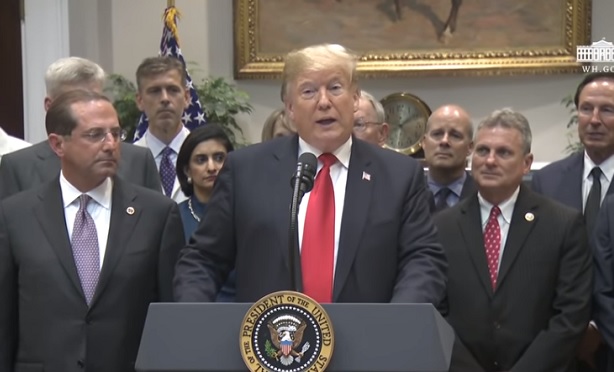 President Donald Trump (Photo: WhiteHouse)
President Donald Trump (Photo: WhiteHouse)
The administration of President Donald Trump is forging aheadwith efforts to revamp an Affordable Care Act program thatcould let each state change how its version of ACA health coverageaccess programs works.
|Agencies today unveiled new guidelines for states that want touse the ACA Section 1332 State Innovation Waiver program.
|In the past, under the administration of former President BarackObama, federal regulators set tight limits on waiver use. Stateshave used waiver authority mainly to set up state-run reinsurance programs for the individual majormedical market.
| The dismantling of
The dismantling of
the ACA: A timeline
A look at the key
developments and changes to
the landmark health
care law over the past year.
Officials at the U.S. Department of The Treasury, the U.S.Department of Health and Human Services (HHS), and the Centers forMedicaid and Medicaid Services (CMS) say they now want to take adifferent, more flexible approach, and to promote useof products such as association health plan coverage andshort-term health insurance.
|Trump administration officials have been talking about makingthose sorts of changes to the Section 1332 waiver program sinceMarch 2017, when Tom Price, Trump's first HHS secretary, announcedan ACA waiver program reboot.
|A preview copy of the 34-page PDF document is available here.
|The official version is set to appear in the Federal RegisterWednesday.
|For a look at seven facts about the new waiver program guidancethat might be of interest to insurance agents and brokers, readon.
|1. The Section 1332 waiver program has a new name.
The Trump administration will be calling it the State Relief andEmpowerment Waiver (SREW) program.
|2. SREW application reviewers will have a strong preference forproposals that favor private-sector solutions.
In the past, Section 1332 waiver program drafters did notmention whether they preferred government-run health programs orprivate insurance programs.
|Some lawmakers who have created ACA alternative bills and ACAchange people's have emphasized that they wanted to give each statethe flexibility to meet local needs.
|In the new SREW guidance, officials evidence that they want topromote more cost-effective health coverage, a lighter burden forthe federal taxpayer, and use of private-sector solutions.
|“For example,” officials write, “states should considereliminating or reducing state-level regulation that limits marketchoice and competition in order to reduce prices for consumers andreduce costs to the federal government, as part of their section1332 waiver applications.”
|3. Trump administration officials say any extra people coveredas a result of waiver programs can have less comprehensivecoverage.
Obama administration officials said that a waiver program shouldincrease access to coverage for at least some, decrease access forno one, and do nothing to reduce the level of benefits providedbelow the ACA individual major medical benefits minimum.
|Trump administration officials argue that a careful reading ofthe coverage quality and access “guardrail” provisions in the ACAstatute “require that coverage be provided to at least a comparablenumber of residents as would occur absent the waiver,” officialssay. “However, the text of the coverage guardrail provision of thestatute is silent as to the type of coverage that is required.”
|4. SREW waivers could give states some new kinds offlexibility.
Under a waiver program, a state should make sure that the numberof people who will have access to coverage that is both affordableand comprehensive will be at least as high as if the statehad no waiver, officials say.
|But additional people who get covered could have cheaper, lesscomprehensive coverage, such as AHP coverage or short-term medicalinsurance, officials say.
|Application reviewers will continue to consider the effects of awaiver proposal on all categories of residents, but “the revisedguardrails will give states more flexibility to decidethat improvements in comprehensiveness and affordability for stateresidents as a whole offset any small detrimental effects forparticular residents,” officials say.
|Here's what officials say about low-income people and peoplewith health problems:
|Some Americans, particularly those with low incomes or highexpected health care costs, may require financial assistance.Policies in section 1332 waiver applications should support stateresidents in need in the purchase of private coverage withfinancial assistance that meets their specific health caresituations.
5. SREW waivers would not be a magic wand.
Under the SREW waiver program, a state could not usethe SREW waiver application to change Medicaid rules.
|Officials say that they will be more likely to approve a waiverthat makes coverage substantially more affordable for some peoplewithout making others substantially worse off than to approve awaiver that makes coverage slightly more affordable for some peoplebut much less affordable for others.
|Because of issues with Internal Revenue Service systems, a stateprobably cannot not make big changes in how the ACA advance premiumtax credit (APTC) health insurance premium subsidy program worksfor state residents, unless the state sets up and runs its ownalternative subsidy program, officials say.
|But a state that has refused to use ACA subsidies toexpand Medicaid to include all adults with income under 100% of thefederal poverty level might be able to make the APTC subsidyavailable to people with incomes under 100% of the federal povertylevel who do not qualify for Medicaid, officials say.
|6. HealthCare.gov is more flexible than it used to be.
Officials say they may be able to offer states more freedom totinker with certain health coverage eligibility rules and otherparameters simply because the HealthCare.gov back-end systems aremore flexible than they used to be.
|7. Members of the public can weigh in on theguidance.
The guidance will take effect immediately, but members of thepublic can comment on the guidance.
|Comments will be due 60 days after the official Federal Registerpublication date.
|One way to file a comment is to submit the comment through thefederal government's Regulations.gov system.
|Read more:
Complete your profile to continue reading and get FREE access to BenefitsPRO, part of your ALM digital membership.
Your access to unlimited BenefitsPRO content isn’t changing.
Once you are an ALM digital member, you’ll receive:
- Critical BenefitsPRO information including cutting edge post-reform success strategies, access to educational webcasts and videos, resources from industry leaders, and informative Newsletters.
- Exclusive discounts on ALM, BenefitsPRO magazine and BenefitsPRO.com events
- Access to other award-winning ALM websites including ThinkAdvisor.com and Law.com
Already have an account? Sign In
© 2024 ALM Global, LLC, All Rights Reserved. Request academic re-use from www.copyright.com. All other uses, submit a request to [email protected]. For more information visit Asset & Logo Licensing.

